Teardrop Engagement Rings: Meaning and Style
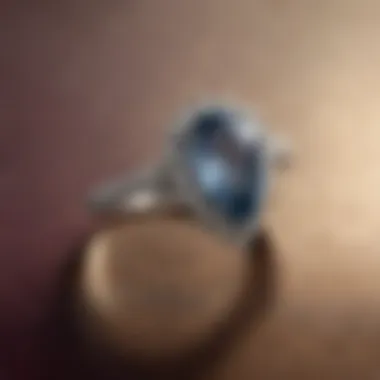
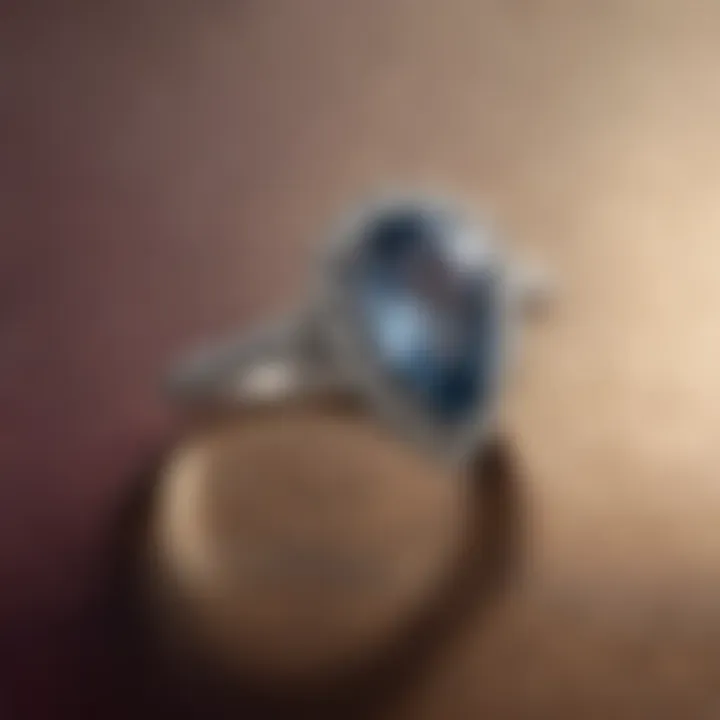
Intro
Teardrop engagement rings have carved out a beautiful niche in the jewelry realm. Their distinctive shape, evoking a sense of both grace and emotion, brings about a profound connection between the symbolism of love and the elegance of design. Those who select this kind of ring not only appreciate its aesthetic appeal but also resonate with the underlying meanings that ripple through its form.
Whether one is a gemstone enthusiast yearning for knowledge or a collector seeking the perfect addition, understanding the deeper roots of teardrop engagement rings can immensely enhance the selection process. This guide will take a closer look at the gemstones that define these rings, delve into their historical significance, and provide insights on selecting the perfect piece.
Gemstone Overview
Definition of Gemstones
To grasp the allure of teardrop engagement rings, one must first understand what gemstones are. Generally speaking, gemstones are natural minerals or organic materials, which are cut and polished to be used in jewelry. Their beauty, rarity, and durability make them treasured elements in adornments worldwide. While diamonds often steal the limelight, other stones like sapphires and emeralds also have their claim to fame, each presenting a unique character.
Classification of Gemstones
Gemstones can broadly be divided into two categories:
- Precious Gemstones: These include diamonds, rubies, sapphires, and emeralds. Often regarded as the crème de la crème due to their rarity and demand, precious stones are seen as benchmarks in gemstone quality.
- Semi-precious Gemstones: This classification encompasses a wide variety, including amethyst, aquamarine, and garnet. While these stones are generally more abundant, their individual beauty and color variations render them highly desirable as well.
What makes teardrop engagement rings particularly fascinating is the choice of gemstone that can be nestled within that elegant shape. From traditional diamonds to unique colored stones, the selection can reveal much about the wearer and their style.
Historical Significance
Origins of Gemstone Use
The use of gemstones dates back thousands of years. Ancient civilizations believed that gemstones possessed mystical powers, thus making them desirable not only for decoration but also for protection and healing. For example, the Egyptians treasured lapis lazuli and turquoise, while the ancient Greeks adorned themselves with amethyst, associating it with moderation and balance.
Cultural Insights: Gemstones in Ancient Civilizations
Gemstones held a unique place in different societies, each attributing its own significance. The Romans often favored emerald for its brilliant green hue, viewing it as a symbol of rebirth. In contrast, Indians celebrated rubies as indicators of wealth and power. Even though the cultures varied, the underlying truth remains: gemstones have long been linked with love, commitment, and connection.
With such rich historical context, teardrop engagement rings can serve as more than just a fashionable choice; they embody the legacies of the past while continuing to resonate with modern sentiments. Each gemstone carries with it tales from yesteryears, adding layers of meaning to this romantic gesture.
"Choosing a teardrop engagement ring is not merely about aesthetics; it’s about connection to history, culture, and personal meaning."
In the age where personalization is paramount, understanding these facets of gemstones enlightens buyers as they navigate the emotional waters of choosing the right engagement ring.
The Symbolism of Teardrop Engagement Rings
Teardrop engagement rings often carry a deep significance that resonates with those who place high value on both aesthetics and meaning. The very shape of the stone embodies a blend of emotional complexity. It's more than just a pretty piece of jewelry; it’s a visual representation of significant moments in life and relationships.
A key aspect of this symbolism lies in its shape. Teardrops remind us of emotions—ranging from joy to sadness—making them uniquely relatable. Their elongated form can evoke a feeling of movement, symbolizing the journey couples undertake together. In a world where choices often boil down to trends, this style stands out because of the story it tells.
Emotional Resonance
When considering teardrop engagement rings, one can’t overlook their emotional resonance. The tear shape draws parallels between the beauty of love and the underlying vulnerabilities that come with it. It’s a tangible reminder that love can bring both happiness and sorrow. This duality adds depth; for many, wearing a teardrop ring signifies acceptance of love's varied nature. The presence of a teardrop gemstone can be empowering, offering a sense of hope and connection, especially for those who value emotional honesty in their relationships.
Moreover, the focus on the wearer’s sentiment often transforms teardrop rings into heirlooms. These pieces carry personal stories and significant milestones, creating a connection that is deep-rooted and nostalgic. The ring transcends fashion; it becomes a part of the owner's identity, often handed down through generations. In a way, it’s as if every wearer adds a layer to the ring's story, enriching its symbolism throughout time.
Connections to Love and Loss
The connections teardrop rings have to love and loss often evoke a compelling narrative. The shape itself serves as a reminder of tears shed in moments of heartache, but also the tears of joy during celebrations of love. For couples, choosing a teardrop engagement ring can symbolize not only their shared present but also their acknowledgment of life's ups and downs together.
In cultural contexts, teardrops have been interpreted differently. Some cultures view them as a sign of remembrance for lost loved ones, while others celebrate them as a positive emblem of emotional growth. This complexity of meaning offers couples a way to personalize their engagement, taking into account hurdles they've overcome or cherished memories they've built.
"In the realm of engagements, the teardrop shape stands out as a multifaceted symbol, merging beauty with the raw essence of human experience."
An appreciation for the deeper emotional connections associated with teardrop rings not only enhances their appeal but also speaks volumes about the wearer’s belief system regarding relationships. Couples may find that selecting such a ring becomes an integral part of their journey, weaving their personal narrative into a piece of art.
Historical Context of Teardrop Shapes
When diving into the intricate world of teardrop engagement rings, it's essential to understand the historical context surrounding their shapes and meanings. These rings are not just a trend; they encapsulate rich stories from the past. Recognizing where this design originated can significantly enhance one's appreciation for their beauty and significance today. The unique teardrop shape has various connotations through different eras and cultures, and knowing these elements gives depth to what might initially seem like a mere aesthetic choice.
Prehistoric Engagement Practices
Long before engagement rings became a customary part of courtship, prehistoric societies had their own methods of symbolizing commitment. Primitive cultures utilized simple materials like shells, stones, and natural materials, frequently crafted into forms that held profound meaning. While the teardrop shape itself may not have been prevalent, the essence of using a symbol to convey emotion was certainly present.
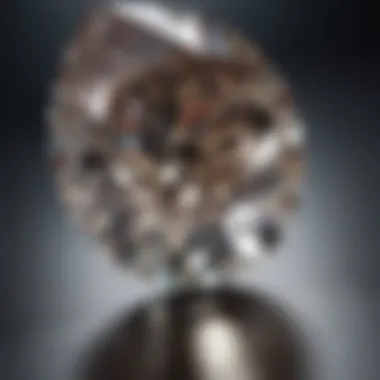
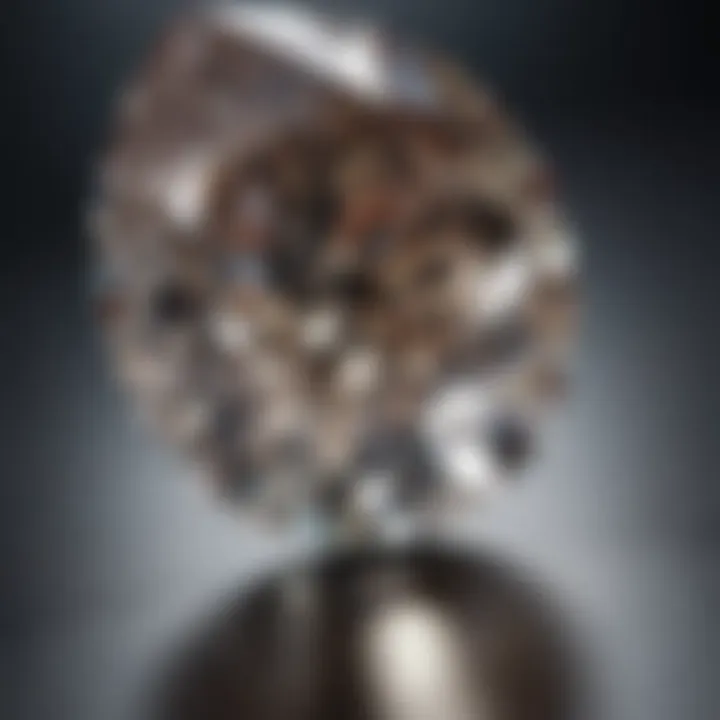
Archaeological discoveries indicate that ancient peoples often selected items with specific shapes, likely believing they carried spiritual significance. The roundness, for instance, represented eternity, while elongated forms might have represented beauty or love lost. The potential ancestor to the modern teardrop could very well have appeared in these early artifacts, not yet refined, but hinting at the emotional weight that shapes could bear.
Victorian Era Influences
Fast forward to the Victorian era, and the teardrop shape entered a more defined narrative. During this time, there was a surge in romanticism and emotional expression, greatly influencing jewelry design. The teardrop symbol became aligned with themes of love and loss, as it mirrored the very essence of human experience—joy mixed with sorrow. It was an ideal representation of the complexities of relationships.
The Victorians had a penchant for intricate storytelling within their jewelry. Teardrop-shaped stones or pendants were often embedded in rings, sometimes illustrating a lost love or a hope for happy beginnings. These rings frequently featured diamond or emerald cuts, having a sleek, elegant line that embodied both grace and emotion—key aspects of Victorian values.
The teardrop shape artistically echoes the duality of love, encapsulating tears of joy and sorrow simultaneously.
To craft these rings took significant skill. Artisans of this era developed techniques that made the stone appear almost teardrop-shaped, even if it was a round or oval stone. The overall impact created a unique allure and made the engagement rings a cherished representation of commitment.
The details of teardrop engagement rings from the Victorian era might still echo in today’s designs. Collectors and gemstone enthusiasts can see patterns and inspirations drawn from this rich history. Overall, the historical significance does not just canvas a timeline; it weaves a narrative that celebrates the human experience, making the choice of a teardrop engagement ring a deeply personal endeavor.
Modern Trends in Teardrop Engagement Rings
In the evolving landscape of engagement jewelry, teardrop rings have taken a prominent spot. Their elegance, coupled with emotional depth, appeals to many couples today. Modern trends indicate a shift toward personalization and unique styles in engagement rings, and teardrop shapes beautifully encapsulate these desires. More than just a pretty design, these rings can symbolize connections, memories, and shared stories. Let’s explore some of the leading trends that have emerged in this captivating segment.
Emerging Styles
Teardrop engagement rings have adopted a few modern twists, marrying tradition with innovation. A fresh approach leans into unconventional gemstone selections. While diamonds remain a classic choice, many couples are now opting for colored gemstones like sapphires, emeralds, or even morganites. This trend resonates with individuals looking to express their uniqueness.
- Vintage-inspired Settings: Many prefer settings that draw inspiration from eras gone by. This can manifest in intricate filigree designs or ornate details that lend a timeless quality to the teardrop shape.
- Mixed Metals: Another evolving trend involves using multiple types of metals—rose gold, yellow gold, and white gold combined in one piece. This eclectic mix not only makes the ring visually stunning but also allows couples to showcase their personal styles.
Teardrop shapes are also being reimagined with geometric touches. For instance, a jagged edge or an asymmetrical design can produce a striking contrast against the fluidity of the teardrop. When adorned with smaller accent stones, these designs create a dazzling effect, amplifying their brilliance.
Prominent Designers and Their Contributions
The relevance of teardrop engagement rings has caught the attention of many jewelers and designers, who are now infusing their creative flair into these pieces.
One noteworthy designer is Nadiya Doss, known for her avant-garde techniques that give her rings a modern edge. Her teardrop pieces often feature unexpected stone combinations and bold designs that challenge conventionality.
David Yurman brings a distinctive artistry to his teardrop rings. His use of twisted metal accents around the gemstone elevates the traditional teardrop into an art form, appealing to customers seeking sophistication.
For those appreciating a more whimsical touch, Maggie Wu plays with colors and textures within teardrop designs, creating rings that feel both fun and elegant. Each piece tells a story, making it very much a reflection of the wearer.
"Artistry and emotion intertwine in rings, captivating not just for their beauty but also for the narratives they hold."
Gemstone Selections for Teardrop Engagement Rings
When it comes to teardrop engagement rings, selecting the right gem is paramount. The choice of gemstone not only impacts the aesthetic appeal of the ring, but it also carries significant meaning and vigor in the relationship. Given the teardrop’s unique shape, which symbolizes both elegance and emotional depth, the gemstone selected forms a crucial element in translating this sentiment. Buyers often find themselves amidst a myriad of options, from the traditional diamond to more unconventional stones, each with its own narrative.
Diamond Versus Alternative Stones
Distinctive Features of Diamonds
Diamonds remain the quintessential choice for engagement rings, including those with teardrop settings. Their innate hardness, assigned a perfect score on the Mohs scale, contributes a sense of durability that appeals to many couples looking for a ring that withstands the test of time. Apart from their durability, diamonds have a remarkable ability to refract light, creating that dazzling sparkle that seems to capture every viewer's attention.
One defining characteristic of diamonds is their clarity and brilliance. The sparkle of a diamond can often be measured in terms of cut, color, clarity, and carat weight, known as the 'Four Cs.' People are often drawn to diamonds not just for their beauty but also for their prestigious reputation as a symbol of forever. For those considering a ring that merges tradition with modernity, a teardrop diamond can be simply enchanting. Yet, it’s crucial to also note the high price point which comes with quality diamonds, leading some to consider alternative gems.
Value of Alternative Gemstones
In contrast, alternative gemstones offer both personal touch and variety. Options such as sapphires, emeralds, and even moissanite can serve as enchanting alternatives without the hefty price tag. Each alternative stone holds its unique meaning and properties, often adding layers of symbolism that resonate deeply with the wearer.
A key feature of alternative gemstones is their diverse color palettes. For instance, sapphires can come in a range of colors beyond blue, while emeralds provide a vibrant green hue that can evoke nature's beauty. These colors allow for a lot of creativity and personal expression. Additionally, the rarity and uniqueness of some stones can make them more appealing. However, one must consider the durability and care needed for certain stones, as some may not stand as strong against day-to-day wear as diamonds do.
Color and Clarity Considerations
Choosing the right color and clarity is a crucial step in selecting a teardrop engagement ring. Color adds a unique flair, and clarity denotes the stone's purity. Buyers need to ponder how these aspects align with personal values and preferences. For some, a flawless diamond might symbolize a perfectionist focus, while for others, a vibrant colored stone might represent a more vibrant and expressive love. Therefore, considering what each element represents can help hone in on the perfect gem.
The choice of gemstone in a teardrop engagement ring is not just about rarity; it's about meaning and connection—each stone has a tale to tell, waiting for the right moment to shine.
Setting Styles to Complement Teardrop Gemstones
Choosing the right setting for a teardrop engagement ring plays a pivotal role in enhancing the stone's beauty and overall aesthetic. This isn't just about style—it's about maximizing the emotional and visual impact of the ring. A well-chosen setting can accentuate the lovely contours of a teardrop gemstone, creating an elegant look that attracts admiring glances while symbolizing the love and commitment it embodies.
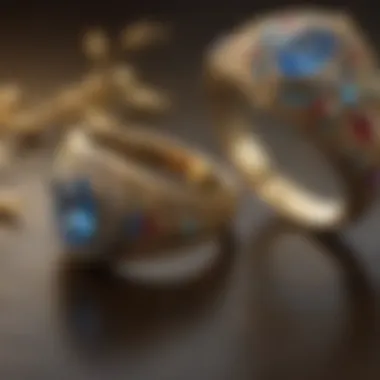
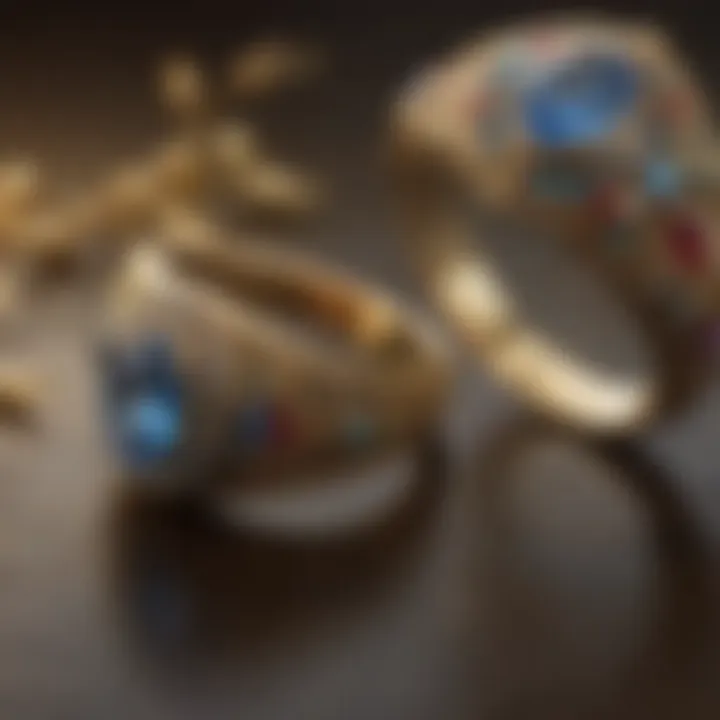
The right setting can also influence how the light interacts with the stone, evoking a certain sparkle or glow. For instance, a classic solitaire may speak to traditional values, while a halo design captures the eye with dazzling riot of brilliance surrounding the teardrop shape. Various settings can also reflect personal tastes or even cultural preferences.
Classic Solitaires
The classic solitaire setting is perhaps the epitome of elegance when it comes to displaying a teardrop gemstone. In this design, the focus is entirely on the stone itself. The clean lines and simplicity allow the teardrop to shine as the star of the show, unobstructed by any elaborate decorations that could steal its spotlight.
One of the main advantages of opting for a solitaire setting is its versatility. It can mix seamlessly with a variety of styles and personal preferences, from minimalist to more ornate tastes. The lack of additional stones means that craftsmanship really counts. A finely crafted teardrop in a solitaire setting showcases the quality of the stone—its cut, clarity, and color—in a way that is unmistakably striking.
Other considerations include:
- Comfort: With a streamlined design, solitaires generally offer comfort and ease of wear, perfect for those who lead an active lifestyle.
- Customizability: Many jewelers offer options for choosing different metals for the band. Gold, platinum, or even more unique options like rose gold can further personalize the ring.
- Timelessness: A solitaire never goes out of style, making it a safe choice for buyers who may not want trendy trends.
Intricate Halo Designs
For those who desire something a bit more elaborate, an intricate halo design can truly elevate a teardrop engagement ring. Here, smaller stones encircle the main teardrop, creating a dazzling frame that catches not just the light, but also the eye. This design brings a dynamic aura to the ring which can make it stand out in a crowd.
The halo setting is particularly appealing for its ability to enhance the perceived size of the center stone. If a teardrop gem is smaller, the halo can give it a grander appearance. This can create a gorgeous visual effect, drawing attention to the added sparkle and radiance around the center gem.
Some key factors to consider with halo designs include:
- Gemstone Selection: The type of stones used in the halo can range from diamonds to colored gemstones, allowing for stunning contrasts or complementary hues.
- Complexity: The intricate detailing can sometimes make these rings more prone to damage. They may require more careful handling, particularly if the owner is active or works with their hands a lot.
- Unique Expression: A halo setting allows for greater design experimentation, which can lead to more unique and personal statements compared to a traditional solitaire.
"In the end, a well-chosen setting doesn’t just hold a gemstone; it elevates it, turning a simple ring into a timeless treasure."
The Craftsmanship Behind Teardrop Engagement Rings
The art of creating teardrop engagement rings goes beyond merely shaping stones. This craftsmanship plays a critical role in ensuring that each piece is not only visually stunning but also imbued with deep emotional resonance. To fully appreciate the allure of these rings, an examination of the intricate techniques and the emphasis on quality is essential.
Techniques in Stone Cutting
The process of cutting gemstones for teardrop engagement rings requires not only skill but also a keen understanding of light and structure. Unlike other shapes, the teardrop cut demands precision to enhance its unique silhouette. The way it reflects light, combined with the gentle tapering from the top to the narrow point at the bottom, creates a captivating sparkle that draws the eye.
A skilled craftsman considers several factors:
- Angle: The angles at which the stone is cut determine how light interacts with it. Proper angling can produce a fiery glow, enhancing the overall appeal.
- Proportions: Balanced proportions between the broader and narrower ends of the teardrop shape are crucial. The relationship between these two areas affects how the ring sits and catches the light.
- Polish: A fine polish is the cherry on top. It makes the surface smooth and reflective, allowing the ring to shimmer under various lighting conditions.
Each of these cutting techniques contributes to the emotional significance that teardrop engagement rings carry. Each cut serves a purpose, allowing the wearer to feel the connection and love symbolized within the ring.
The Importance of Quality in Jewelry Production
When it comes to teardrop engagement rings, quality is non-negotiable. The materials used, from the gemstones to the metals, define not just durability but also the overall aesthetic appeal of the piece. A higher quality gemstone can make the teardrop appear more vibrant and laden with character.
Considerations for quality include:
- Gemstone Authenticity: Genuine stones carry energy and history. Whether it’s a diamond, sapphire, or morganite, authenticity matters.
- Metal Choices: The band's material impacts both comfort and durability. Gold, platinum, and palladium are often preferred for their resilience and classic appearance.
- Finishing Touches: The way gemstones are set can elevate a ring from ordinary to extraordinary. Bezel, prong, and tension settings all have a different impact on the ring's final look.
"Craftsmanship is the bridge between the designer's vision and the wearer's experience."
Investing in high-quality craftsmanship pays dividends not only in longevity but also in the emotional weight it carries for the wearer. The symbolic nature of an engagement ring is heightened when both the design and the quality of materials reflect the careful thought and love behind it.
Cultural Significance of Teardrop Engagement Rings
Teardrop engagement rings extend beyond mere aesthetics; they encapsulate rich cultural narratives and emotional connotations that resonate through generations. These rings are not just symbols of commitment but also carry weight in various traditions and practices across the globe. Understanding the cultural significance of teardrop engagement rings allows buyers and admirers alike to appreciate the deeper meanings behind their designs and choices.
Diverse Cultural Interpretations
Throughout history, the teardrop shape has been widely regarded as a representation of both joy and sadness, embodying the complex emotions tied to love and commitment. For instance, in various Eastern cultures, the teardrop can symbolize purification or the cleansing of one’s spirit—frequently viewed as a mark of fresh beginnings in a relationship. Similarly, in some Native American traditions, the shape is linked to the idea of the water element, embodying life and continuity.
In contrast, Western views often associate the teardrop with the bittersweet nature of love; it acknowledges the challenges that come with deep emotional connections. It acts as a reminder that love can bring both joy and sorrow. This duality provides a distinctive richness that many couples appreciate. The teardrop silhouette elegantly harmonizes with both celebratory moments and the more sobering aspects of relationships, thus making it an appealing choice.
"Love is a tapestry woven with both tears and laughter. The teardrop shape captures this intricate balance beautifully."
Role in Modern Engagement Rituals
In contemporary society, teardrop engagement rings have found their place in modern engagement rituals, acting as a blend between tradition and personal expression. Couples today are increasingly favoring custom jewelry that reflects their unique journeys. The teardrop design, often chosen for its feminine allure and distinctive form, allows for personal flair through gemstone selection and setting styles.
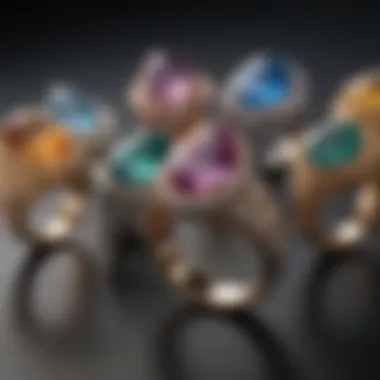
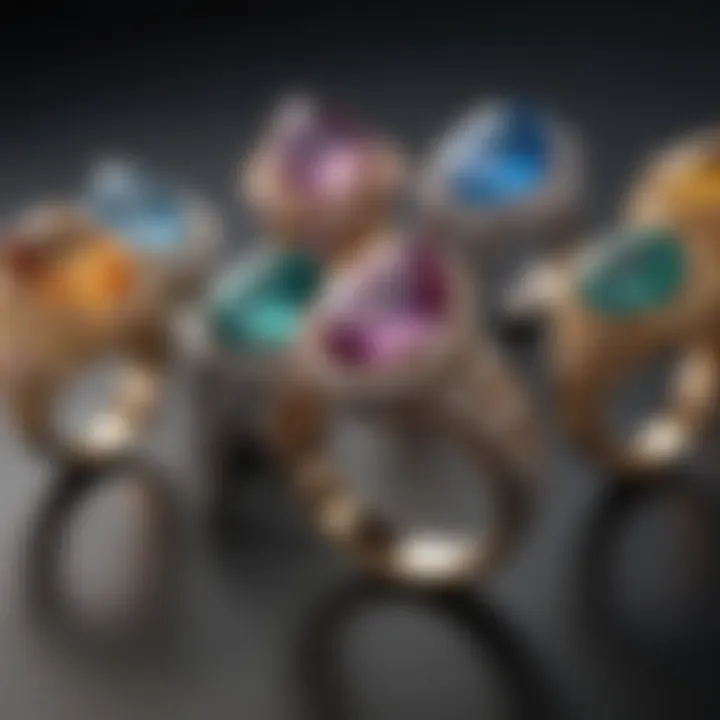
Some rituals now place emphasis on the story behind the ring itself. For example, it’s becoming common for partners to select stones that carry personal significance, whether from their respective heritage or based on meaningful experiences shared together. This very approach ties back to the historical weight given to engagement rings, further imbuing the teardrop shape with meaning that resonates with the couple’s shared narrative.
Moreover, as more individuals embrace alternative methods of engagement, like proposal pop-ups or intimate gatherings, the role of the engagement ring also evolves. The teardrop remains a popular choice as a centerpiece that complements the changing dynamics of love and partnership, catering to diverse values without losing its charm.
Care and Maintenance of Teardrop Engagement Rings
When you invest in a teardrop engagement ring, it embodies more than mere aesthetics; it carries emotional weight and history. Proper care and maintenance are essential to ensure that both the ring and its precious stone remain as captivating as the day they were given. Understanding how to preserve this meaningful piece goes beyond surface cleaning; it dives into safeguarding the very essence of what the ring represents.
Cleaning Tips for Longevity
To maintain the beauty and brilliance of a teardrop engagement ring, regular cleaning is paramount. As dust and oils can obscure its shimmer and shine, consider these effective cleaning methods:
- Gentle Soap Solution: Create a mixture of warm water and a drop of mild dish soap. Soak your ring for a few minutes, then use a soft brush to gently remove any buildup. Rinse thoroughly to avoid soap residue.
- Ultrasonic Cleaners: If the ring is heavily soiled, ultrasonic clean can provide a deep clean. Just be sure to check that your precious stone can withstand such treatment. Some stones, like opals, could be more fragile.
- Professional Cleaning Services: If in doubt, particularly with intricate settings or valuable gemstones, seeking services of a professional jeweler can offer peace of mind. A jeweler has the right tools and expertise to ensure your ring is cleaned without damage.
Also, remember to wipe your ring gently with a soft cloth after removing it to further prevent dullness.
Safeguarding Against Damage
Protecting a teardrop engagement ring from damage is as crucial as the cleaning itself. Here are some practical considerations:
- Avoid Wearing While Doing Activities: Whether washing dishes or exercising, it’s wise to take off your ring. Chemicals in cleaning products or excessive force can weaken the setting or scratch the stone.
- Secure Storage: When not in use, store your ring in a fabric-lined box or a soft pouch, separate from other jewelry. This prevents scratching and tangling with other pieces.
- Regular Inspections: Every few months, check the setting and the gemstone for any signs of wear or damage. If you spot something unusual, taking it to a jeweler for inspection can save you from potential loss.
"A bit of care can go a long way in preserving not just the sparkle of your ring, but also the memories attached to it."
By following these tips, you can ensure that your teardrop engagement ring remains a radiant symbol of love and commitment, enduring through the years and stories it’s destined to tell.
Emotional Connections to Teardrop Rings
Teardrop engagement rings resonate on many emotional levels. They provide more than just visual appeal; they can evoke deep feelings and personal connections. For many, choosing a ring is not simply about its aesthetic; it's about the story behind it, the memories tied to that piece of jewelry, and the emotions it represents.
The allure of a teardrop shape grabs attention because it symbolizes both beauty and fragility. The graceful curve of a teardrop can represent the journey of love, from the joyful moments to the challenges faced along the way. This duality—marrying both joy and sorrow—creates a profound connection. When someone wears a teardrop engagement ring, they may be reminded of significant milestones in their relationship, which adds layers of meaning to the piece itself.
Emotional considerations here also reflect a broader narrative of how we engage with sentimental objects. Jewelry can serve as a carrier of memories, capturing everything from a first date to an engagement proposal. Thus, when selecting a teardrop engagement ring, individuals may think critically about their personal stories and what it signifies for their future.
"Jewelry has a unique way of intertwining with our life's stories, often capturing the essence of our emotional highs and lows, especially when it comes to engagement rings."
Personal Stories and Memories
Personal narratives often surround the acquisition of a teardrop engagement ring. Every ring represents a unique history and a tangible token of love. For some, the choice may stem from a family heirloom. Maybe a grandmother had a stunning teardrop ring that sparked admiration throughout generations. Sharing that piece of the past can deepen bonds and enrich the experience of finding the right ring.
In contrast, for others, the ring might represent a culmination of memories made together. Perhaps during a weekend getaway in the mountains, an impromptu proposal occurred. Later, the couple reflects on that moment when admiring the teardrop ring. It serves as a constant reminder of laughter shared and promises made. Memories form an intrinsic part of the emotional appeal; they make each piece singular.
Symbolism in Relationships
Teardrop rings also carry significant symbolism in relationships. The shape itself can convey a deep connection between partners, representing their journey through love's ups and downs. In many cultures, the teardrop has been associated with renewal and transformation, signifying a couple's commitment to grow together while navigating life's challenges.
Within relationships, a teardrop engagement ring can symbolize emotional support and shared experiences. When one partner wears it, they're reminded of their commitment to each other and the resilience of their bond. The elegant form can serve as a metaphor for the emotional currents they navigate together—both the tears of joy and the sorrows endured.
As such, the engagement ring is more than a piece of jewelry; it is a testament to the fact that love encompasses a myriad of experiences—joyful, painful, and everything in between. It's this depth of meaning that elevates the teardrop engagement ring from a mere accessory to a pivotal element in a couple's storytelling.
Epilogue: The Lasting Allure of Teardrop Engagement Rings
In summary, teardrop engagement rings embody a captivating blend of emotional depth and aesthetic charm that resonates with many couples today. This conclusion ties together the essential elements discussed in this article, underlining the significance and appeal of these exquisite pieces of jewelry. From their historical roots to modern interpretations, teardrop rings participate in the narrative of love, connection, and personal expression.
Understanding the symbolic importance of these rings is paramount. They often signify not just a commitment to love, but also a journey—marked by both joy and sorrow. The teardrop shape itself speaks to the dual aspects of affectionate relationships; it communicates elegance while simultaneously evoking a deeper emotional connection that can remind wearers of cherished memories.
As we've delved into the various facets of this topic, it’s clear that the allure of teardrop engagement rings extends beyond their visual appeal. They invite wearers to explore their significance, bridging personal stories and cultural meanings. By considering the aspects of design, historical context, and modern trends, prospective buyers can appreciate the uniqueness that teardrop engagement rings bring to the table.
Recapping Symbolic Importance
The symbolism of teardrop engagement rings cannot be overstated. They represent a range of profound emotions, from happiness to sorrow. Here are some key points to recap their significance:
- Connection: The teardrop shape creates a sense of linked emotional experiences.
- Elegance: These rings embody a timelessness that conveys sophistication.
- Individual Stories: Each ring carries a personalized narrative reflective of the relationship it symbolizes.
- Cultural Significance: Across various cultures, teardrop motifs illustrate stories of love and longing, making them universally appealing.
Ultimately, these rings celebrate the multifaceted nature of love—both its joys and struggles, uniting them in a single elegant design.
Final Thoughts on Choosing the Right Ring
Choosing the right teardrop engagement ring is not just about the visual appeal; it's about understanding what resonates personally with you and your partner. Here are a few considerations to keep in mind:
- Personal Taste: Identify the styles and settings that speak to both of you. Consider whether you prefer a classic solitaire or an intricate halo.
- Gemstone Selection: Engage with the significance of various gemstones. From diamonds to alternatives, each stone carries its unique story and qualities.
- Setting Importance: The setting can elevate the beauty of the teardrop shape. It’s essential to find a design that accentuates your chosen gemstone effectively.
- Cultural Elements: Factor in any cultural traditions or personal anecdotes that may influence your choice.
Ultimately, selecting the perfect teardrop engagement ring is a journey filled with meaning. It’s about finding that blend of elegance, emotional resonance, and individual touch that will carry you forward as you embark on the beautiful adventure of life's next chapter together.



